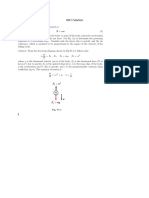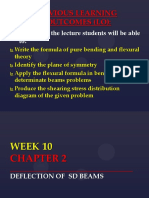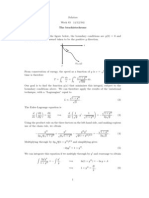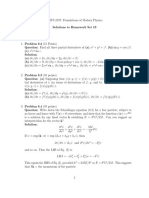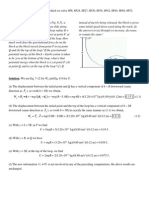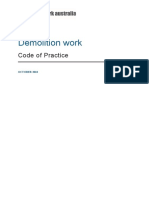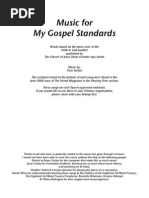FEM Quiz
FEM Quiz
Uploaded by
mkdev2004Copyright:
Available Formats
FEM Quiz
FEM Quiz
Uploaded by
mkdev2004Original Description:
Copyright
Available Formats
Share this document
Did you find this document useful?
Is this content inappropriate?
Copyright:
Available Formats
FEM Quiz
FEM Quiz
Uploaded by
mkdev2004Copyright:
Available Formats
1
1
Finite Element Analysis QUIZ I (Closed Book)
Answer all questions.
All questions carry equal marks.
Maximum marks: 20
Time: 120 minutes
Question 1:
Establish the differential equation of equilibrium of the problem shown in the figure below
and the (geometric and force) boundary conditions.
Question 2:
The governing equation for a fully developed steady laminar flow of a Newtonian viscous
fluid on an inclined flat surface (see the figure below) is given by
2
2
cos 0 0 + u = s s
d v
g x L
dx
where = coefficient of viscosity, v = fluid velocity, = density, g = acceleration due to
gravity, u = angle between the inclined surface and the vertical. The boundary conditions are
given by
( )
0
0 (zero shear stress) 0 (no slip)
=
= =
x
dv
, v L
dx
.
Find the velocity distribution ( ) v x using the least squares weighted residual method,
assuming trial solution to be ( )
2
0 1 2
= + + v x a a x a x .
2
Question 3:
Use Galerkins method of weighted residuals to obtain a one-term approximation to the
solution of the differential equation
2
2
4 0 1 + = s s
d y
y x x
dx
with boundary conditions ( ) ( ) 0 0 1 1 = = y , y . Hint: Assume trial solution to be
( )
1
1 = + y a x x x .
Question 4:
Consider a simple bar fixed at one end (x = 0) and subjected to a concentrated force at the
other end (x = 180) as shown in the figure below. Using the notation given in the figure, the
total potential of the structure is
180
2
180
0
1
100
2
=
| |
H =
|
\ .
(
(
]
x
du
EA dx u
dx
and the essential boundary condition is
0
0
=
=
x
u . Calculate the displacement and stress
distributions using the variational method with the following displacement assumptions:
0 100
100
100 100
1 100 180
80 80
B
B C
xu
u , x
x x
u u u , x
= s s
| | | |
= + s s
| |
\ . \ .
where
B
u and
C
u are the displacements at points B and C.
3
3
Question 5:
The plane truss shown in the figure below consists of three members connected to each other
and to the walls by pin joints. The members make equal angles with each other, and Element
2 is vertical. The members are identical to each other with properties: Youngs modulus
E = 206 GPa, cross-sectional area A = 110
4
m
2
, and length L = 1 m. An inclined force
F = 20,000 N is applied at Node 1. Solve for the displacements at Node 1 and stresses in the
three elements.
You might also like
- Indian Institute of Technology, Madras Department of Civil Engineering CE5610: Finite Element Analysis QUIZ I (Closed Book) Jan-May 2013Document2 pagesIndian Institute of Technology, Madras Department of Civil Engineering CE5610: Finite Element Analysis QUIZ I (Closed Book) Jan-May 2013Saurabh TakNo ratings yet
- HW 1 A 2013 SolutionDocument7 pagesHW 1 A 2013 SolutioncarsongbakerNo ratings yet
- FEM Question BankDocument13 pagesFEM Question BankmanisekNo ratings yet
- Home Exercise 2: Due Date: 27 May 2016Document2 pagesHome Exercise 2: Due Date: 27 May 2016Irfan JamilNo ratings yet
- HW 1 SolutionDocument9 pagesHW 1 SolutionbharathNo ratings yet
- Advanced Higher Maths Exam 2015Document8 pagesAdvanced Higher Maths Exam 2015StephenMcINo ratings yet
- MATH21Document11 pagesMATH21NilushaNo ratings yet
- Week 10 - Deflection of BeamDocument53 pagesWeek 10 - Deflection of BeamRichie BobbyNo ratings yet
- 1 ExDocument7 pages1 ExTrung PhanNo ratings yet
- FemDocument10 pagesFemSeenu CnuNo ratings yet
- First Order Differential Equations Chapter 1.3Document13 pagesFirst Order Differential Equations Chapter 1.3Yap Yih ShanNo ratings yet
- Torsion Module 6 With SolutionsDocument26 pagesTorsion Module 6 With Solutionsmaran.suguNo ratings yet
- Finite DifferenceDocument14 pagesFinite DifferenceAli H. JabbarNo ratings yet
- ME223 Tut5Document5 pagesME223 Tut5Lily MaronNo ratings yet
- AE 321 Homework 7 Due in Class On November 1, 2013: Problem 1Document2 pagesAE 321 Homework 7 Due in Class On November 1, 2013: Problem 1Arthur DingNo ratings yet
- MP206 Ex1Document6 pagesMP206 Ex1anush_swaminathanNo ratings yet
- First Order Differential Equations: 2.1 Quadrature MethodDocument8 pagesFirst Order Differential Equations: 2.1 Quadrature MethodTeferiNo ratings yet
- Stress AnalysisDocument15 pagesStress AnalysisRed OrangeNo ratings yet
- BaristocranaDocument3 pagesBaristocranajonnathan_andreNo ratings yet
- One Dimensional Wave EquationDocument9 pagesOne Dimensional Wave EquationMario BacicNo ratings yet
- MPI 2324 hw6Document2 pagesMPI 2324 hw6toby121802No ratings yet
- 1803Document254 pages1803dinhanhminhqtNo ratings yet
- Final 05Document5 pagesFinal 05Sutirtha SenguptaNo ratings yet
- Project 3Document3 pagesProject 3igerhard23No ratings yet
- Tutorial 1Document6 pagesTutorial 1Ashutosh DhamaleNo ratings yet
- NP Tel ProblemsDocument18 pagesNP Tel ProblemsSreedevi KrishnakumarNo ratings yet
- UNIT4 Applications of Partial Differential Equations.286201632Document36 pagesUNIT4 Applications of Partial Differential Equations.286201632Jack AshrafNo ratings yet
- Advanced Engineering MathematicsDocument21 pagesAdvanced Engineering MathematicsSilambarasan VeluchamyNo ratings yet
- 3-d ElasticityDocument40 pages3-d Elasticityp_sahoo8686No ratings yet
- Assignment 8: Math. Phys. 2 (PEU 326) : Due May 18thDocument2 pagesAssignment 8: Math. Phys. 2 (PEU 326) : Due May 18thMohamed IBrahimNo ratings yet
- Magna College of Engineering: Me2353 - Finite Element AnalysisDocument3 pagesMagna College of Engineering: Me2353 - Finite Element AnalysisAda AdaNo ratings yet
- Wave EquationDocument10 pagesWave EquationjohnjabarajNo ratings yet
- Maths13 02Document14 pagesMaths13 02Random PersonNo ratings yet
- Maths Chapter - 1Document9 pagesMaths Chapter - 1AbushNo ratings yet
- Thin Rectangular Plate-Airy Stress FunctionDocument1 pageThin Rectangular Plate-Airy Stress FunctionAshutosh Kumar100% (1)
- Advanced Mathematics Exercises: 9 de Septiembre de 2016Document3 pagesAdvanced Mathematics Exercises: 9 de Septiembre de 2016RaulNo ratings yet
- 2.7 Geometric Interpretation, Slope Fields, and Euler's MethodDocument10 pages2.7 Geometric Interpretation, Slope Fields, and Euler's MethodAbinashSahooNo ratings yet
- HW 10 SolutionsDocument4 pagesHW 10 SolutionsNur Hanif DarmawanNo ratings yet
- 2 Two Dimensional Random Variables.9402036Document36 pages2 Two Dimensional Random Variables.9402036naramgaribaluprakashNo ratings yet
- Advanced Graphical TechniquesDocument11 pagesAdvanced Graphical TechniquescataiceNo ratings yet
- Fem 16M-1Document13 pagesFem 16M-1Abdul NazèêrNo ratings yet
- NXNXNX.: Ux Nxu Nxu NxuDocument1 pageNXNXNX.: Ux Nxu Nxu NxuSSNo ratings yet
- ProblemSet 8Document1 pageProblemSet 8Basharat SaigalNo ratings yet
- Numerical Solution of The Problem of DistributionDocument8 pagesNumerical Solution of The Problem of DistributionLina MartinezNo ratings yet
- Ma203 006 PDFDocument39 pagesMa203 006 PDFShibani Shankar RayNo ratings yet
- Cee 457 HWDocument3 pagesCee 457 HWmoNo ratings yet
- HW05 - Energy ConservationDocument7 pagesHW05 - Energy ConservationBradley Nartowt0% (1)
- MIT2 080JF13 Lecture2 PDFDocument26 pagesMIT2 080JF13 Lecture2 PDFAbhilashJanaNo ratings yet
- Exercises Vector AnalysisDocument3 pagesExercises Vector AnalysisTafseer AhmedNo ratings yet
- Math207 HW2Document2 pagesMath207 HW2PramodNo ratings yet
- Mathematics 1St First Order Linear Differential Equations 2Nd Second Order Linear Differential Equations Laplace Fourier Bessel MathematicsFrom EverandMathematics 1St First Order Linear Differential Equations 2Nd Second Order Linear Differential Equations Laplace Fourier Bessel MathematicsNo ratings yet
- Transformation of Axes (Geometry) Mathematics Question BankFrom EverandTransformation of Axes (Geometry) Mathematics Question BankRating: 3 out of 5 stars3/5 (1)
- Student's Solutions Manual and Supplementary Materials for Econometric Analysis of Cross Section and Panel Data, second editionFrom EverandStudent's Solutions Manual and Supplementary Materials for Econometric Analysis of Cross Section and Panel Data, second editionNo ratings yet
- Problems in Quantum Mechanics: Third EditionFrom EverandProblems in Quantum Mechanics: Third EditionRating: 3 out of 5 stars3/5 (2)
- A-level Maths Revision: Cheeky Revision ShortcutsFrom EverandA-level Maths Revision: Cheeky Revision ShortcutsRating: 3.5 out of 5 stars3.5/5 (8)
- ALGEBRA SIMPLIFIED EQUATIONS WORKBOOK WITH ANSWERS: Linear Equations, Quadratic Equations, Systems of EquationsFrom EverandALGEBRA SIMPLIFIED EQUATIONS WORKBOOK WITH ANSWERS: Linear Equations, Quadratic Equations, Systems of EquationsNo ratings yet
- Hirschfeld - Euthymius and His Monastery in The Judean DesertDocument33 pagesHirschfeld - Euthymius and His Monastery in The Judean Desertsybilla_byzantina67% (3)
- Lennox BerkeleyDocument9 pagesLennox BerkeleySergio Miguel MiguelNo ratings yet
- Milk ProcesScan Datasheet - GBDocument2 pagesMilk ProcesScan Datasheet - GBttk_maniNo ratings yet
- Model Cop Demolition WorkDocument59 pagesModel Cop Demolition WorkAntares OrionNo ratings yet
- Ubc 1992 Spring Brzustowski John PDFDocument64 pagesUbc 1992 Spring Brzustowski John PDFHari Madhavan Krishna KumarNo ratings yet
- Ignou Mlis PDF BookDocument31 pagesIgnou Mlis PDF BookMadhurima Paul DasNo ratings yet
- DRAFT FL COVID-19 Vaccination Plan - 16oct2020Document51 pagesDRAFT FL COVID-19 Vaccination Plan - 16oct202010News WTSPNo ratings yet
- NV-SJ200 205 207Document0 pagesNV-SJ200 205 207zilikonNo ratings yet
- Nad 310Document32 pagesNad 310mcegliNo ratings yet
- Selamawit Seifu 34Document56 pagesSelamawit Seifu 34Alemayehu KebedeNo ratings yet
- Activity Sheets Computer1Document10 pagesActivity Sheets Computer1doreen mae dubriaNo ratings yet
- Grading System in K-12 CurriculumDocument26 pagesGrading System in K-12 CurriculumAlle Eiram Padillo0% (1)
- Safety and First Aid Teaching GuideDocument8 pagesSafety and First Aid Teaching GuideNOEL BADECAONo ratings yet
- ACT Scaling Test: Sample QuestionsDocument68 pagesACT Scaling Test: Sample Questionsinder191No ratings yet
- Catalog QuickdeliveryDocument112 pagesCatalog QuickdeliveryJerico LlovidoNo ratings yet
- My Gospel Standards MusicDocument8 pagesMy Gospel Standards MusicwelcomehomefarmNo ratings yet
- Galvapole Catalogue 2008Document16 pagesGalvapole Catalogue 2008rieza_fNo ratings yet
- Freezers - Brochure - 80 - EN - FinalDocument4 pagesFreezers - Brochure - 80 - EN - FinalHanane ZgtNo ratings yet
- Installation and Start of myWMS LOS - myWMS PDFDocument3 pagesInstallation and Start of myWMS LOS - myWMS PDFeggman80No ratings yet
- Geometry Test 2006 Rice Math Tournament February 25, 2006Document2 pagesGeometry Test 2006 Rice Math Tournament February 25, 2006RongLiuNo ratings yet
- In Uence of Type of Loading (Tension or Bending) On Cracking Behaviour of Reinforced Concrete Elements. Experimental StudyDocument26 pagesIn Uence of Type of Loading (Tension or Bending) On Cracking Behaviour of Reinforced Concrete Elements. Experimental Studydmt7nzztcmNo ratings yet
- STS Course Syllabus 1Document10 pagesSTS Course Syllabus 1Antoneth AlviolaNo ratings yet
- Course Information COURSE OUTLINE OME 651Document7 pagesCourse Information COURSE OUTLINE OME 651Kinanda KachelemaNo ratings yet
- An Introduction To Auger Electron SpectrosDocument25 pagesAn Introduction To Auger Electron SpectrosWinta BreaNo ratings yet
- Ethical Delphi: ManualDocument43 pagesEthical Delphi: ManualTamara Chachi-Baía do SantiagoNo ratings yet
- Assignment of Vectors and Three Dimensional GeometryDocument4 pagesAssignment of Vectors and Three Dimensional GeometryWill The WiseNo ratings yet
- PaintingsDocument2 pagesPaintingsAmaris SoleilNo ratings yet
- Understanding Anatomy and PhysiologyDocument7 pagesUnderstanding Anatomy and PhysiologyYasmeen AlnajjarNo ratings yet
- Chandru and Anr V State SC Feb 2019Document25 pagesChandru and Anr V State SC Feb 2019Abhishek YadavNo ratings yet
- Chenab Bridge Construction ProjectDocument6 pagesChenab Bridge Construction Projectaniruddha nikamNo ratings yet




